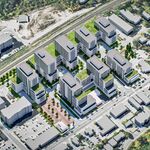EnviroTO
Senior Member
Where did Tory say that this would not require DRL? They explicitly said once every 15 minutes.
And how could it relieve Bloor-Yonge station much? It doesn't intercept the Danforth line until Kennedy? Most people board the Danforth line west of Kennedy.
I agree that it wouldn't relieve it much but in every discussion about SmartTracks he de-prioritized the DRL.
Globe and Mail: "Mr. Tory criticized conventional plans for a tunnelled downtown relief line, which is usually envisioned as a U-shaped local subway line into the core that intersects the Bloor-Danforth line to the east and west of Yonge. That plan has serious problems, he said, arguing it would take too long, disrupt neighbourhoods and “do nothing†to extend transit into the suburbs and ease congestion by getting people out of their vehicles."
There was already a plan for RER by the province so what is the SmartTracks plan other than to say it will involve the TTC and will de-prioritize the DRL?





